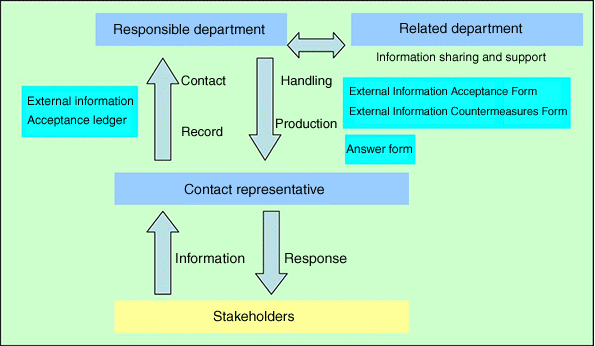KPI
-
Item
Total number of complaints concerning the environment formally submitted to the system for handling complaints concerning human rights
* Number subject to official procedures -
FY 2016 results
(Consolidated) 0
-
FY 2017 results
(Consolidated) 0
Responsible Departments
Basic activities: each business location
Consolidation: Environmental Protection Promotion Department
Stance and Target
Why is “Environmental Grievance Mechanisms” a critical issue to be addressed?
Explanation of the reason and background
The Yokohama Rubber Group, which has production bases in Japan and overseas, views the minimizing of the adverse effects of plants (such as noise and odors), communication with local residents, and creating trust relationships by continuing to live up to expectations, to be important for achieving sustainable operations in each region.
The Environmental Grievance Mechanisms is a system that allows anyone to file complaints, principally local residents that live near plants. It is a system that will enable us to make fully-fledged environmental improvements for local residents and also lead to environmental improvements within plants. For this reason, the Environmental Grievance Mechanisms has been selected as an import initiative for the Yokohama Rubber Group.
Policies and stance towards handling complaints
We aim to clarify the method for receiving information related to the environment both internally and externally throughout the entire company and achieve proper communications with external stakeholders, while promptly and accurately sharing information between business locations in order to prevent the occurrence of similar types of complaints throughout the entire company.
Overview of the Environmental Grievance Mechanisms
External environment information gathered at each business location that could involve environmental risks is entered in the External Information Acceptance Ledger, and it is determined whether the information constitutes an external complaint based on the external information standards of the company-wide guidelines. If such information is certified as an external complaint, it is handled in accordance with the emergency response standards of the company-wide guidelines. For information that is not certified as an external complaint, the relevant department will be contacted as appropriate if deemed necessary by the environment representative of each business location.
In the event of warning, guidance, or recommendations from the government, an External Information Acceptance Form will be issued and simultaneously sent to the Environmental Protection Promotion Department, other business locations, and the Tire and MB (industrial products) Production Environmental Task Force.
The Environmental Protection Promotion Department will provide advice on countermeasures while receiving advice from the Legal Department, and the entire Group will cooperate in response.
Complaint process flow

Resolution process when a complaint is submitted
If an environmental management representative has deemed that there has been an external complaint, an External Information Countermeasures Form will be issued and simultaneously sent to the Environmental Protection Promotion Department, other business locations, and the Tire and MB Production Environmental Task Force.
The Environmental Management Task Force of the business location will submit an answer form to an external information provider after reporting and gaining approval from the manager of the business location for all documents from complaint receipt to response. This answer form will be sent and shared if there has been a request from other business locations or the Environmental Protection Promotion Department.
Users of the Grievance Mechanisms
It can be used by all stakeholders.
Methods for spreading awareness of the Grievance Mechanisms
We have formulated company-wide guidelines for the Environmental Grievance Mechanisms that will be distributed to all business locations in Japan and overseas. In addition, every time regular audits are conducted at each business location, we will work to ensure awareness of the overview of the system and how to use it. At the same time, we will use opportunities such as the Environment Council to deepen an understanding of the system at each business location.
As an example, when construction work takes place inside a plant, we communicate with local residents by sending out advanced notices of the period of work, hours of work each day, and a telephone number to call to local residents.
Monitoring of the effectiveness of the Grievance Mechanisms
We have decided on internal monitors and external monitors for each business location to gather information through regular visits, etc. conduct communication, and check that the complaint handling system is operating effectively.
Vision (attainment goal) / target
Manuals have been developed on complaint collection and response, and a system capable of uniform response throughout the Yokohama Rubber Group has been adopted. We will continue to utilize the monitor system so that the system continues to be operated appropriately.
We will aim for zero complaints.
Measures for vision achievement
As measures to strengthen coordination between each business location, we will conduct regular audits and define business locations with high risks of environmental issues as focus business locations for regular follow-up, Environment Council attendance, and guidance on improvement methods.
Review of FY 2017 Activities
In fiscal year 2017, no complaints were received.
We will continue to reinforce stakeholder engagement to maintain this track record of no complaints.
We will also examine and address the views and requests of outside monitors to prevent complaints from occurring in the future.
In the future, by analyzing the causes of complaints and developing suitable countermeasures, we will ensure that we are able to offer considerate explanations to the parties filing complaints and respond appropriately to their requests.
Issues and Future Improvement Measures
We will continue efforts to raise awareness of the complaint handling system both internally and externally, while continuing monitoring the system to enable appropriate system operation.
In regard to countermeasures for odor issues, which constitute one cause of complaints, it is difficult to adopt uniform measures because the types and components of odors differ by business location, and they are highly susceptible to the sensitivity of individual people. With the aim of achieving zero complaints, we will conduct a detailed analysis of causes and install a reactor tank, which is effective at eliminating odorous components (through reaction, absorption, etc.,), to increase the effectiveness of our countermeasures.
Going forward, we will continue to roll out initiatives horizontally and implement further countermeasures.

